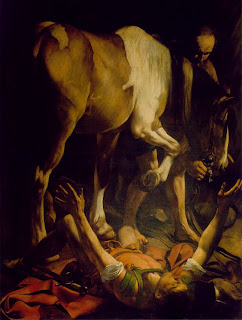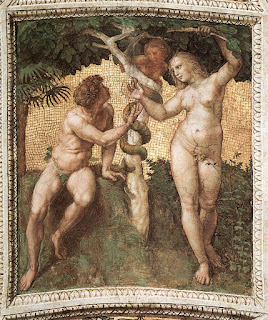In my previous
three posts on Titian’s “Sacred and Profane Love” I have discussed the
figures in the antique relief that is placed so prominently in the center of
the famous painting. I have argued that the three scenes represent great
sinners: Adam and Eve around the Tree of Knowledge on the right; Cain and Abel
toward the center; and on the left side St. Paul being thrown from his horse on
the road to Damascus. The relief then has a direct relationship to the real
subject of the painting that I have identified as, “The Conversion of Mary
Magdalen.” See link.
Today I would like
to deal with some possible objections to my interpretation and also present a
summary account of the relief. At
the outset I would like to point out that my interpretation of the relief does not fly in the
face of any settled opinion on the subject. For the most part scholars have
either thrown in the towel, or just offered the
scantiest of guesses.
However, in 2001
Paul Joannides, in his study of the young Titian, provided a somewhat thorough
examination. He noted the similarity of the relief to an equally mysterious one
in an earlier work by Titian, "Jacopo Pesaro presented to St. Peter."
The grey marble trough of the sarcophagus contains a relief. Like that below Peter in Jacopo Pesaro presented to St. Peter, it is not based on any identified classical source but seems to be the invention of the artist.*
In the case of the "Sacred and Profane Love" h e
admitted that it would be “reasonable to suppose that the relief had some
significance” but noted that so far there has been no plausible elucidation. He
did agree that it “would seem odd if so prominent a scene had no relevance to
the main one,” and so decided to take a close look. Here is his description of
the relief in the “Sacred and Profane Love”.
Starting from the left an engagement of some type, perhaps but not necessarily, a struggle, is proceeding between two figures, one, at the far left clearly male, the other, partly obscured behind the hind quarters of a horse, perhaps, but not certainly, female. The horse, which bears neither saddle nor bridle, is being led calmly left to right by a nude male figure, although since he is partly obscured by the shrub, it is difficult to ascertain exactly the nature of his action. This scene is separated by the bronze nozzle from that to the right which shows a violent episode; a nude woman lying on the ground, is being beaten—probably but not certainly on the buttocks—by a nude man. Taken literally, the scene appears to be one of punishment rather than murder or sexual assault. This group is represented in notional high relief; behind it, in lower relief, is a nude woman, standing to the left of a tree, across which a nude man is advancing towards her from the right, but without any clear intent.
He
then paused for a moment to consider the possibility that the nude woman lying
on the ground could be a man and the possible implication.
If, on the right-hand side, the sprawled figure could reasonably be identified as male, then the scene might represent Cain killing Abel, in which case the couple behind could be their parents, Adam and Eve either side of the tree of knowledge. But aside from the relative unlikelihood of representing an Old Testament scene on a classical sarcophagus, such a reading of the figures is not convincing, nor would it appear to relate in any way to the scene at the left. The most one can say about it is that a punishment and a conflict do seem to be represented and that it is treated in a specific—and surely meaningful way.
In
other words, Joannides saw Adam and Eve, and Cain and Abel but couldn’t believe
his own eyes. Two objections deterred him from seeing the relief as a “sacred”
subject. In the first place, “there was the relative unlikelihood of
representing an Old Testament scene on a classical sarcophagus.” Secondly, he
could not see how the biblical scenes from Genesis could relate to the left
hand side of the relief. A third objection was left unsaid. Since there is a
great likelihood that the centrally located relief is related to the painting
as a whole, to see a scriptural subject in the relief would point to a “sacred”
subject for the “Sacred and Profane Love.”
Here
is another line of reasoning. The figure on the left hand side of the painting
is St. Paul who not only called himself the greatest of sinners but who was
also one of the great propounders of the doctrine of original sin. He referred
to it continually in his letters and felt its effect in his own life. He argued
that because of the Fall, sin and death entered the world, and that it was only
through the grace of God that he was freed from their clutches.
The
conversion of St. Paul fits very well in a relief that also depicts Adam and
Eve, as well as the story of Cain and Abel, the first instance of the presence
of sin and death in the world. If this relief is a sacred subject, scholars
might also want to take another look at Titian’s earlier attempt at an antique
relief in Jacopo Pesaro being Presented
to St. Peter. The subject of that relief has also eluded identification but
I think I see Adam and Eve on the left. Why is it unthinkable that Titian would
use an antique relief to depict a scriptural scene? Art historians have to fit
their theories to the actual work of the artist and not vice versa.
Finally,
I have wondered, along with some correspondents, why the action in the relief
seems to move from right to left. You will notice that Joannides in his above
description of the relief read it in the traditional way from left to right.
Normally, in a narrative painting the action does begin in the left background
and progresses through the mid-ground until it culminates with the foreground
figures who are either in the center or off to the right. Giovanni Bellini did
so in the Frick “St. Francis in the Desert”, and so did Giorgione in the
“Tempest.”
In my
interpretation of the “Sacred and Profane Love”, I have argued that Titian
employed the same left to right narrative scheme. As is often the case the city
in the left background is a place of spiritual and even physical danger. The
sinful Magdalen has left the city behind and now sits on the sarcophagus in the
foreground contemplating her own conversion. We move across the water filled
sarcophagus to see her own resurrection to a new life. She appears on the right
side of the sarcophagus bereft of her worldly finery. Behind her in the right
background the scene, where she will spend the rest of her life, is bucolic and
peaceful.
I can
only guess as to why Titian might have chosen to have the action on the relief
move from right to left. First, it could have been just a painterly decision to
have the action on the relief counterbalance the action in the main scene. It
is after all a very large painting. I also wonder if he might have just used a
copy of an engraving as a cartoon for the relief and just flipped the scene.
On a
more profound level, perhaps Titian or his patron wanted the action on the
relief to move backwards in time. So we can begin on the left and trace the
action back from a story of a conversion from a life of sin to the origins of
sin itself. Here is my view of the relief reading from right to left.
Adam
stands on the extreme right on one side of the tree. Eve is on the other side
and her outstretched arm actually touches her son Cain in the act of murdering
his brother. Abel lies on the ground but he faces left away from his parents.
In the medieval period Abel, whose sacrifice was acceptable to the Lord, was
always viewed as a precursor of Christ. Dividing the relief in half is the
spigot with flowing water, and right next to it is the emblem of the donor. On
the left side, Paul’s attendant still leads the horse toward Damascus but Paul
falls off in the other direction towards a new life.
###
###
*Paul Joannides, Titian
to 1518, The Assumption of Genius,
Yale, 2001, p. 192.














